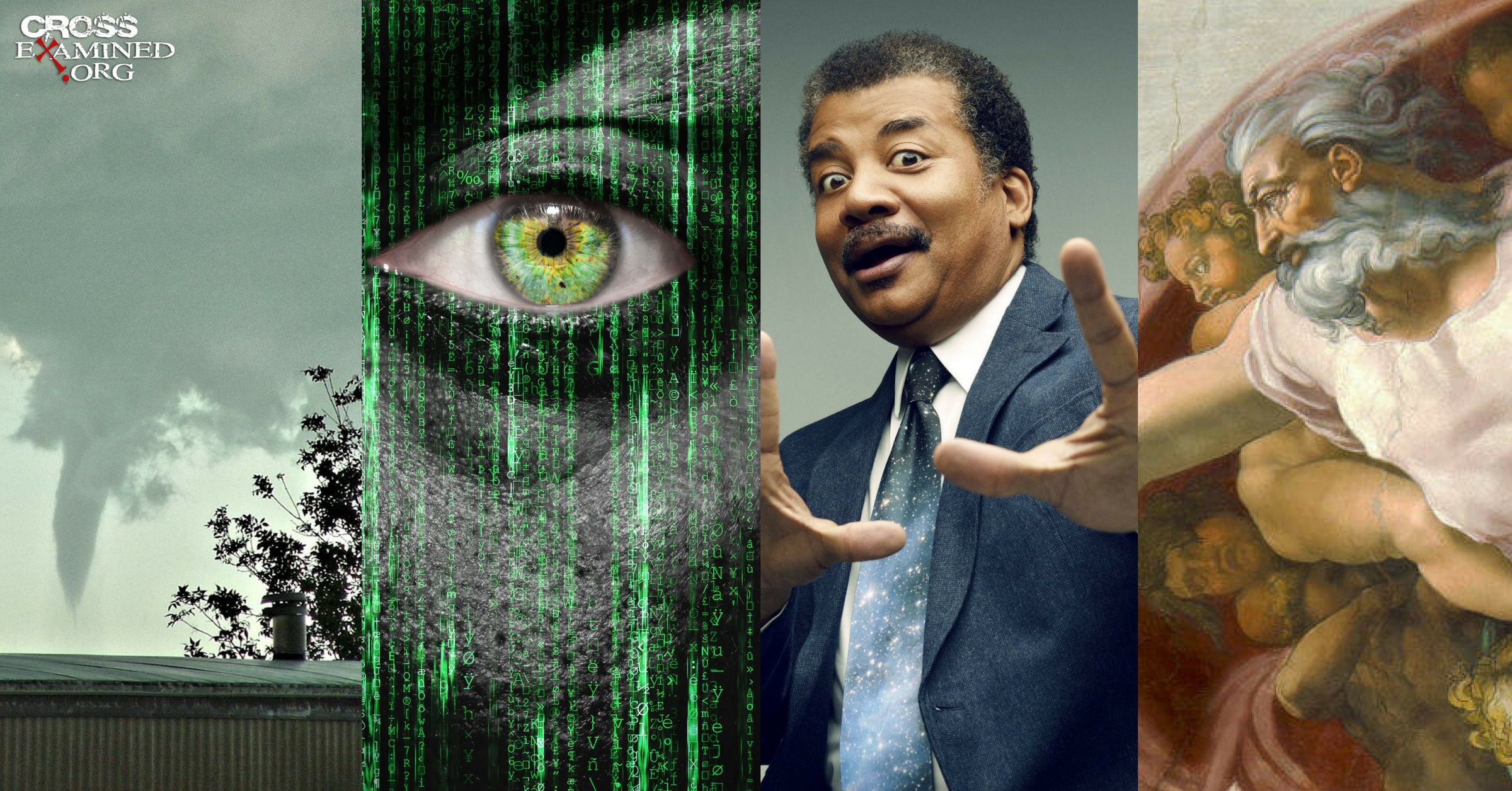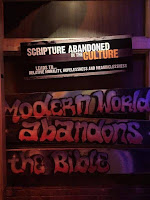By Luke Nix
Introduction
For nearly all my life, I’ve had a fascination with the physical sciences. Meteorology and astronomy were two of them that always caught and kept my attention as a kid. In my teens was when I started to focus more on information technology, and in my twenties, I was drawn to defending the truth of the Christian worldview through science, philosophy, and other knowledge disciplines. Living in Oklahoma, the weather is always in the news, and being that I frequent philosophical and scientific sites, popular astronomer Dr. Neil deGrasse Tyson comes across my screen once in a while as well. In the last year, a few different articles have shown up from the meteorological, astronomical, and philosophical worlds, which the combination is what caught my attention. Today, I want to take some time to show how technology, being used to simulate natural phenomena, can be used to show that God exists, and I will address a popular naturalistic alternative explanation that was proposed by Tyson (and others). Let’s start with the weather and super-computers.
Tornadoes And Technology
One of my earliest memories was that of a weather event in Lubbock, TX in the mid-to-late 80s. I was about five years old, and my brother was only two. We were with our parents at the local mall on a spring afternoon. This was pretty typical and nothing exciting, but what happened that afternoon seared this memory into my brain for life. As we were wrapping up our trip and on our way out, nearly everyone in the mall started running frantically, screaming and crying. My parents grabbed my brother and me, and we ran outside to see what was going on. All I remember once we were outside was seeing traffic stopped on an overpass not far from the parking lot and an odd funnel-shaped cloud connecting the sky to the ground. As a five-year-old, I had no idea what was going on, but I knew that that funnel was the cause, and it terrified me. Later, it was explained to me that what I saw was a tornado. Since then, I have had a great fascination with tornadoes, and living in Oklahoma has definitely provided a great opportunity to feed that fascination. Over the years, like most mid-westerners, I have had a few close calls with tornadoes, including one that inspired a blog post a few years ago about God’s potential purposes for allowing natural evil.
While I never went to school for meteorology, I did get to take one meteorology course at the local college one spring semester. That same semester I had the opportunity to watch a supercell develop overhead. While that also is nothing odd for a mid-westerner, this was the first time that I purposely went outside to watch it and was actually paying close attention. Seeing the rapid circulation of the dark clouds around me and the scuds develop and get sucked into the circulation was astonishing. Luckily, no tornado developed, but we did get some nice-sized hail. This particular experience in my mid-20s was one of my turning points for realizing the incredible beauty and power of one of nature’s most destructive forces (at least for my area). If you’ve never experienced a storm this way, take a look at this time-lapse video of a supercell and imagine yourself watching it develop from directly below it:
Nebraska Supercells – 4k StormLapse from Chad Cowan on Vimeo.
Historically, weather has been quite challenging to predict despite the continued increase in power of today’s super-computers and the amount of data that they process in the latest models. In early 2017 atmospheric scientist Dr. Leigh Orf at the University of Madison released a video produced by the most extensive and precise simulation of a real supercell that became tornadic. The EF-5 tornado struck Oklahoma in 2011, and Dr. Orf’s team reproduced the entire supercell for the life of the tornado. Here is the simulation video he released:
The enormity and beauty of the storm astound me which creates a sense of wonder and worship of the Creator (not the creator of the simulation, but the Creator of nature which produced the storm). But something else does as well. The amount of time required, on our fastest computers to simulate the visuals of such a small portion of our universe for such a short period of time with precision orders of magnitude less than what this universe exhibits, created that same sense of wonder and worship in me. Some naturalists have posited that perhaps this universe is a simulation, much like what was explored in the movie trilogy, “The Matrix.”
What If We Live In A Simulation?
Popular astronomer Dr. Neil deGrasse Tyson moderated a scientific debate a couple years ago where he suggested that science lends credit to the idea that we live in a simulation. Being that he is an agnostic (if not an atheist) he proposes this idea as a possible naturalistic explanation for the evidence coming from the sciences. The idea that this universe may be a simulation presses the bounds of the word “ludicrous” for a naturalist to make for three reasons.
First, the fact that a naturalist would even suggest such a thing is a philosophical concession to intelligent design on two levels. We know that simulations can only be the product of intelligent designers: the designers of the hardware and the designers of the software. To suggest this universe is a simulation is to suggest the universe was intelligently designed. Let us also not forget what a simulation is: an imprecise representation of something else. So, not only has the naturalist conceded intelligent design but they have merely pushed back the explanation, for they must then assume a universe of greater complexity and precision is what is being imprecisely simulated in the designed hardware by designed software. If this universe is, indeed, a simulation then it has a Designer.
Second, just as the 2011 Oklahoma City tornado was more complex than Dr. Leigh Orf’s simulation, the universe that this universe is imprecisely simulating would be more complex as well, so the naturalist has inadvertently increased the difficulty level of the problem of design because they now need to explain the complexity and design in the universe that our universe is simulating.
Third, all simulations (once the hardware is designed, programmed, and put together, and the software is designed and loaded) must begin. Someone must be there to start the simulation. If the universe is a simulation, all simulations begin, and anything that begins has a cause outside itself, then the simulation (universe) has a beginning outside itself. The universe, if a simulation, indeed must have a Beginner.
If the naturalist wishes to posit that our universe is a simulation, then they have conceded that our universe is designed (thus has a designer), that there exists another universe of greater complexity and design, and that the universe has a beginning (thus a beginner). If a naturalist proposes the option of a simulation, these three issues can be used to show how they have actually granted God’s existence.
Do We Live In A Simulation?
The but the question remains: “Do we live in a computer simulation?” The latest research published in the journal Scientific Advances addresses this possibility. According to one summary of this paper,
“The researchers calculated that just storing information about a couple of hundred electrons would require a computer memory that would physically require more atoms than exist in the universe.”
In other words, not a chance! Lucky for the naturalist the problem is not actually more difficult due to our universe being some big simulation. But they are still stuck with the universe’s beginning and the universe’s design and fine-tuning. The naturalist simply cannot escape these two realities. The possibility of the universe being a simulation appeared to explain these realities (the agent could have been an alien race in the multiverse, or intelligent machines like in “The Matrix,” after all), but when working out the logical implications, it did not, and recent research shows that the whole discussion is moot anyway. So, the naturalist, even if they were right, is still stuck. Evidence for design in the universe is so strong that the naturalist cannot reasonably appeal to an “appearance of design;” they know that they must come up with a way to affirm that the design is real, and they almost (not really) had a way to affirm actual design via the simulation hypothesis, but now they must deny it yet again.
Conclusion
If we conclude from the design in the universe that it is a simulation (based on what we know about the origins of computer simulations), but we discover that the universe is real (not a simulation), shall we then deny the design of the universe again just to avoid the notion of a cosmic Designer and Creator? Shall we further deny the design of the computer simulation by the scientists and say that the simulation was nothing special and just a “chance” occurrence? I do not believe that Dr. Orf would appreciate such a conclusion. Let’s now apply this to the universe.
Rather than denying the evidence, there is an option that has been established, not only through the process of elimination (a negative argument) but also through argument by analogy (positive argument): God. Just as we know that purposeful designs created by human designers exhibit lesser levels of complexity and specificity that we see in the universe and we know that those levels are the product of designers, so too we can know that the greater levels of complexity and specificity that we see in the universe are the products of a Designer. We can either follow the scientific evidence where it leads, or we can continue to deny it, even though we know deep down that to do so is a denial of all that is rational. Given the numerous other positive arguments for the God of the Bible, when the whole of reality is considered (quoting homicide detective J. Warner Wallace from his book Forensic Faith– “Everything counts as evidence”), only the God of the Bible stands as the logical explanation. We can either follow the evidence and logic and surrender our lives to Jesus Christ, or we can deny reason and the evidence and live our lives in opposition to our Creator and Savior. It is our free choice, and no one is morally responsible for making the wrong decision but us.
For more on God’s existence from the Sciences, I recommend:
Improbable Planet: How Earth Became Humanity’s Home by Dr. Hugh Ross
Where The Conflict Realy Lies: Science, Religion, and Naturalism by Dr. Alvin Plantinga
Origins of Life: Biblical and Evolutionary Models Face Off by Dr. Fazale Rana and Dr. Hugh Ross
Origin Science: A Proposal for the Creation-Evolution Controversy by Dr. Norman Geisler
Original Blog Source: http://bit.ly/2gNtq3R








